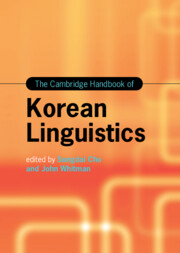Book contents
- The Cambridge Handbook of Korean Linguistics
- Cambridge Handbooks in Language and Linguistics
- The Cambridge Handbook of Korean Linguistics
- Copyright page
- Contents
- Figures
- Tables
- Contributors
- Preface
- Acknowledgments
- Abbreviations
- Part I Korean Overview
- Part II Phonetics and Phonology
- Part III Morphology and Syntax
- Part IV Semantics and Pragmatics
- Part V Sociolinguistics and Psycholinguistics
- Part VI Language Pedagogy
- Chapter 26 The Genre-Based Approach to Korean Language Teaching: A Curriculum Application
- Chapter 27 Towards Integrated Performance Assessment
- Chapter 28 Interactional Competence in the Korean Language
- Chapter 29 From Bilingual Speakers to Korean Heritage Language Learners
- Chapter 30 Language Policy and Its Effect in South Korea
- Index
- References
Chapter 26 - The Genre-Based Approach to Korean Language Teaching: A Curriculum Application
from Part VI - Language Pedagogy
Published online by Cambridge University Press: 30 September 2022
- The Cambridge Handbook of Korean Linguistics
- Cambridge Handbooks in Language and Linguistics
- The Cambridge Handbook of Korean Linguistics
- Copyright page
- Contents
- Figures
- Tables
- Contributors
- Preface
- Acknowledgments
- Abbreviations
- Part I Korean Overview
- Part II Phonetics and Phonology
- Part III Morphology and Syntax
- Part IV Semantics and Pragmatics
- Part V Sociolinguistics and Psycholinguistics
- Part VI Language Pedagogy
- Chapter 26 The Genre-Based Approach to Korean Language Teaching: A Curriculum Application
- Chapter 27 Towards Integrated Performance Assessment
- Chapter 28 Interactional Competence in the Korean Language
- Chapter 29 From Bilingual Speakers to Korean Heritage Language Learners
- Chapter 30 Language Policy and Its Effect in South Korea
- Index
- References
Summary
Chapter 26 aims to rationalize and discuss how a genre-based approach is best applied as a guiding principle for different levels of the Korean language curricula. The chapter showcases the application of the genre-based approach to intermediate level language teaching using a story genre, that is, folktales. After presenting the theoretical basis for the genre-based approach in foreign language education, the chapter highlights the empirically attested benefits of applying this framework. It then discusses issues pertaining to developing such courses – practical issues to consider, activities and tasks to be used in classroom instructions with examples, assessing learning outcomes, and so on. The proposal made in this chapter is an attempt to expand the horizon beyond what most previous research on this topic has achieved and to maximize the benefits of the genre-based curriculum in a lower level course with the popular genre of folktales.
- Type
- Chapter
- Information
- The Cambridge Handbook of Korean Linguistics , pp. 751 - 768Publisher: Cambridge University PressPrint publication year: 2022



